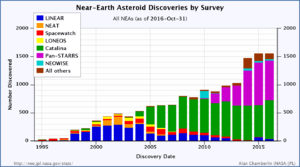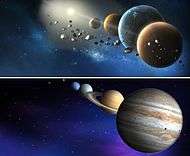Near-Earth Object Camera
 | |
| Names | NEOCam |
|---|---|
| Operator | NASA/JPL |
| Website |
neocam |
| Mission duration | 4 years (planned) |
| Start of mission | |
| Launch date | 2021 (proposed) |
| Main | |
| Diameter | 50 cm (20 in) |
| Wavelengths | Near infrared 6–10 µm |
NEOCam (the Near-Earth Object Camera) is a proposed space-based infrared telescope designed to survey the Solar System for potentially hazardous asteroids.[1] Proposals for NEOCam were submitted in 2006, 2010, and 2015 to the NASA Discovery Program. In 2010, NEOCam was selected to receive technology development funding to design and test new detectors optimized for asteroid and comet detection and discovery.[2][3] NEOCam would survey from the Earth–Sun L1 Lagrange point, allowing it to look close to the Sun and see objects inside Earth's orbit.[4][5]
On 30 September 2015, NASA's Discovery Program selected NEOCam along with other four mission concepts for refinement during the next year. Each mission received $3 million for a one-year study. The winner will be chosen around December 2016[6] and must be ready to launch by the end of 2021.[7][8] NEOCam would be the successor of NEOWISE mission. The principal investigator is Amy Mainzer of the NASA Jet Propulsion Laboratory (JPL).[9]
Overview
The primary scientific goal of NEOCam is to discover and characterize the orbit of most of the potentially hazardous asteroids larger than 140 meters over the course of its 4-year mission. NEOCam's field of view is large enough to allow the mission to discover tens of thousands of new NEOs with sizes as small as 30 m (98 ft) in diameter.[10] Secondary science goals include detection and characterization of approximately one million asteroids in the asteroid belt and thousands of comets.[11] In the event that a potential impactor is discovered, officials at NASA Headquarters will be immediately notified according to standard procedures already in place.
Scientific payload
The scientific payload consists of an infrared telescope and a wide-field camera operating at two thermal infrared wavelengths.[11] The mission would likely use a special mercury–cadmium–telluride detector called HgCdTe Astronomical Wide Area Infrared Imager (HAWAII) in development by Teledyne.[12] This detector has good infrared performance without the use of a cryogenic fluid refrigeration.[12] NEOcam will keep relatively cool by operating at the L1 Lagrange point and employing a Sun shield. The prototype sensor was successfully tested in April 2013.[13]
Optical communications
If selected for launch, the mission may use the Deep Space Optical Communications option.[14] This option gives a cash bonus for using lasers to communicate with Earth beyond the orbit of the Moon.[14][15] The laser communication package is not required, but, if included on NEOCam, would grant an additional 30 million USD bonus on top of the base (450 million USD) budget.[15] One of the reasons for interest in optical communication in space is the potential for a dramatic increased data rate; the OPALS program achieved transferring a video in 3.5 seconds that traditionally would have taken 10 minutes (this was from Earth's surface to ISS's orbit).[16] The LADEE mission previously tested two-way free-space optical communication from lunar orbit in 2013.
Images


|
LINEAR NEAT Spacewatch LONEOS |
CSS Pan-STARRS NEOWISE All others |

See also
- Discovery Program semi-finalists with this mission
- DAVINCI (spacecraft) (Venus entry probe)
- Lucy (spacecraft) (asteroids orbiter)
- Psyche (spacecraft) (asteroid orbiter)
- VERITAS (spacecraft) (Venus orbiter)
- NEOs search projects
- B612 Foundation (Organization that has studied NEOs and tried to develop similar mission)
- Near Earth Object Surveillance Satellite (Canadian small sat to find NEOs)
- The Spaceguard Foundation (Organization that tries to locate NEOs)
- Whipple, a proposed space telescope in the Discovery program
- Related topics
References
- ↑ "NEOCam website". JPL. 2013-04-15. Retrieved 2013-07-06.
- ↑ "NEOCam Mission description and history". JPL. Retrieved 2013-07-06.
- ↑ NASA, Discovery, JPL, Anthony Goodeill. "Discovery News, May 2011". NASA. Retrieved 2013-07-06.
- ↑ "NEOCam orbit description". JPL. Retrieved 2013-07-06.
- ↑ Mainzer, Amanda K. (September 2009), "NEOCam: The Near-Earth Object Camera", Bulletin of the American Astronomical Society, American Astronomical Society, 38: 568
- ↑ Clark, Stephen (September 7, 2016). "NASA official says new mission selections on track despite InSight woes". Spaceflight Now. Retrieved 2016-09-08.
- ↑ Clark, Stephen (24 February 2014). "NASA receives proposals for new planetary science mission". Space Flight Now. Retrieved 2015-02-25.
- ↑ Kane, Van (December 2, 2014). "Selecting the Next Creative Idea for Exploring the Solar System". Planetary Society. Retrieved 2015-02-10.
- ↑ "Amy Mainzer's JPL homepage". JPL. 2003-08-25. Retrieved 2013-07-06.
- ↑ "NEOCam - Instrument". NASA - JPL. Retrieved 2015-11-12.
- 1 2 "NEOCam Science". JPL. Retrieved 2013-07-06.
- 1 2 "Near Earth Object Camera (NEOCam)". Teledyne Scientific Imaging. Teledyne Scientific Imaging. Retrieved 2015-11-12.
- ↑ "NASA-Funded Asteroid Tracking Sensor Passes Key Test". NASA News. April 15, 2015. Retrieved 2015-11-12.
- 1 2 Clark, Stephen (5 October 2015). "NASA might pick two Discovery missions, but at a price". Spaceflight Now. Retrieved 2015-11-12.
- 1 2 Leone, Dan (November 5, 2014). "NASA Drops Laser Comm Requirement From Discovery Solicitation". Space News. Retrieved 2015-11-12.
- ↑ Landau, Elizabeth (9 December 2014). "OPALS: Light Beams Let Data Rates Soar". Jet Propulsion Laboratory. NASA. Retrieved 18 December 2014.
